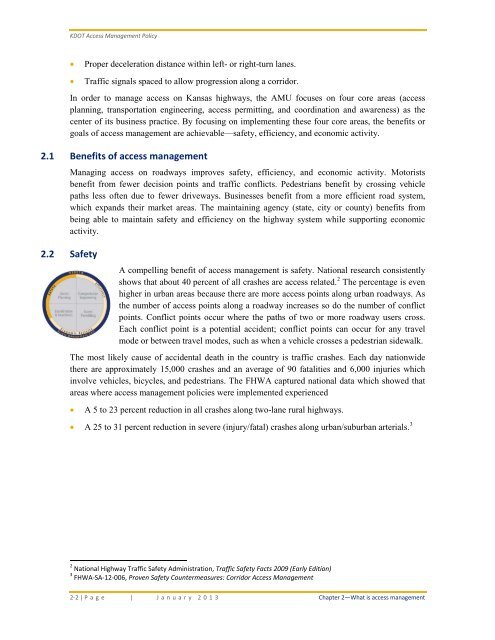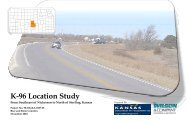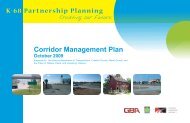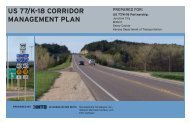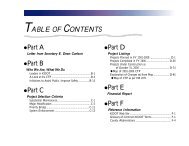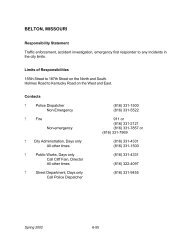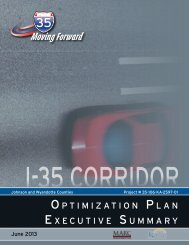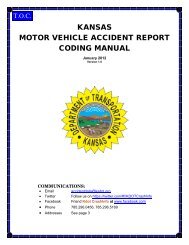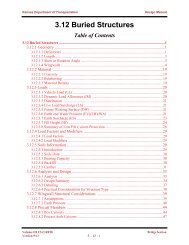- Page 3: Certification Pursuant to the autho
- Page 7: KDOT Access Management Unit Mission
- Page 10 and 11: KDOT Access Management Policy 4.3.3
- Page 12 and 13: KDOT Access Management Policy 8.5.1
- Page 14 and 15: KDOT Access Management Policy Figur
- Page 16 and 17: KDOT Access Management Policy Table
- Page 19 and 20: Acronyms and Definitions: Common ac
- Page 21 and 22: KDOT Access Management Policy 1.4 A
- Page 23: KDOT Access Management Policy 1.5.1
- Page 28 and 29: KDOT Access Management Policy Natio
- Page 30 and 31: KDOT Access Management Policy 2.2.2
- Page 32 and 33: KDOT Access Management Policy 2.4.1
- Page 34 and 35: KDOT Access Management Policy 3.1 K
- Page 36 and 37: KDOT Access Management Policy 3.1.1
- Page 38 and 39: KDOT Access Management Policy • S
- Page 40 and 41: KDOT Access Management Policy Table
- Page 42 and 43: KDOT Access Management Policy 4.1.1
- Page 44 and 45: KDOT Access Management Policy Table
- Page 46 and 47: KDOT Access Management Policy 4.1.3
- Page 48 and 49: KDOT Access Management Policy 4.2.1
- Page 50 and 51: KDOT Access Management Policy • E
- Page 52 and 53: KDOT Access Management Policy • A
- Page 54 and 55: KDOT Access Management Policy 4.3.1
- Page 56 and 57: KDOT Access Management Policy Table
- Page 58 and 59: KDOT Access Management Policy 4.3.2
- Page 60 and 61: KDOT Access Management Policy 4.3.2
- Page 62 and 63: KDOT Access Management Policy Two-l
- Page 64 and 65: KDOT Access Management Policy Table
- Page 66 and 67: KDOT Access Management Policy Figur
- Page 68 and 69: KDOT Access Management Policy 4.3.5
- Page 70 and 71: KDOT Access Management Policy 4.3.5
- Page 72 and 73: KDOT Access Management Policy 4.3.7
- Page 74 and 75: KDOT Access Management Policy 4.3.7
- Page 76 and 77:
KDOT Access Management Policy desig
- Page 78 and 79:
KDOT Access Management Policy requi
- Page 80 and 81:
KDOT Access Management Policy With
- Page 82 and 83:
KDOT Access Management Policy Acces
- Page 84 and 85:
KDOT Access Management Policy Figur
- Page 86 and 87:
KDOT Access Management Policy 4.4.1
- Page 88 and 89:
KDOT Access Management Policy Table
- Page 90 and 91:
KDOT Access Management Policy Figur
- Page 92 and 93:
KDOT Access Management Policy Witho
- Page 94 and 95:
KDOT Access Management Policy 4.4.6
- Page 96 and 97:
KDOT Access Management Policy 4.4.7
- Page 98 and 99:
KDOT Access Management Policy Figur
- Page 100 and 101:
KDOT Access Management Policy 4.4.1
- Page 102 and 103:
KDOT Access Management Policy Figur
- Page 104 and 105:
KDOT Access Management Policy 4.4.1
- Page 106 and 107:
KDOT Access Management Policy 4.4.1
- Page 108 and 109:
KDOT Access Management Policy highw
- Page 110 and 111:
KDOT Access Management Policy 4.5.2
- Page 112 and 113:
KDOT Access Management Policy Table
- Page 114 and 115:
KDOT Access Management Policy 4.5.3
- Page 116 and 117:
KDOT Access Management Policy For b
- Page 118 and 119:
KDOT Access Management Policy Figur
- Page 120 and 121:
KDOT Access Management Policy KDOT
- Page 122 and 123:
KDOT Access Management Policy Figur
- Page 124 and 125:
KDOT Access Management Policy 4.6.1
- Page 126 and 127:
KDOT Access Management Policy Figur
- Page 128 and 129:
KDOT Access Management Policy The p
- Page 130 and 131:
KDOT Access Management Policy Figur
- Page 132 and 133:
KDOT Access Management Policy would
- Page 134 and 135:
KDOT Access Management Policy Figur
- Page 137 and 138:
Acronyms and Definitions: Common ac
- Page 139 and 140:
KDOT Access Management Policy 5.1.1
- Page 141 and 142:
KDOT Access Management Policy Figur
- Page 143 and 144:
KDOT Access Management Policy • W
- Page 145 and 146:
KDOT Access Management Policy proce
- Page 147 and 148:
KDOT Access Management Policy 5.3 R
- Page 149 and 150:
KDOT Access Management Policy the p
- Page 151 and 152:
KDOT Access Management Policy • D
- Page 153 and 154:
KDOT Access Management Policy • S
- Page 155 and 156:
KDOT Access Management Policy 5.4.4
- Page 157 and 158:
KDOT Access Management Policy 5.4.5
- Page 159 and 160:
Acronyms and Definitions: Common ac
- Page 161:
6.3 Raising local awareness KDOT Ac
- Page 164 and 165:
KDOT Access Management Policy 7.1.1
- Page 166 and 167:
KDOT Access Management Policy them
- Page 168 and 169:
KDOT Access Management Policy 7.2.3
- Page 171 and 172:
Chapter 8 Appendices 8.1 Acronyms,
- Page 173 and 174:
KDOT Access Management Policy 8.1.2
- Page 175 and 176:
KDOT Access Management Policy acces
- Page 177 and 178:
KDOT Access Management Policy area
- Page 179 and 180:
KDOT Access Management Policy corri
- Page 181 and 182:
KDOT Access Management Policy Highw
- Page 183 and 184:
KDOT Access Management Policy merge
- Page 185 and 186:
KDOT Access Management Policy Secre
- Page 187 and 188:
KDOT Access Management Policy trip
- Page 189 and 190:
KDOT Access Management Policy 8.2 K
- Page 191 and 192:
KDOT Access Management Policy Distr
- Page 193 and 194:
KDOT Access Management Policy 8.4 D
- Page 195 and 196:
KDOT Access Management Policy 8.4.1
- Page 197 and 198:
KDOT Access Management Policy 8.4.1
- Page 199 and 200:
KDOT Access Management Policy 8.4.1
- Page 201 and 202:
KDOT Access Management Policy 8.4.2
- Page 203 and 204:
KDOT Access Management Policy 8.4.2
- Page 205 and 206:
KDOT Access Management Policy 8.4.3
- Page 207 and 208:
KDOT Access Management Policy 8.4.3
- Page 209 and 210:
KDOT Access Management Policy 8.4.3
- Page 211 and 212:
KDOT Access Management Policy 8.4.4
- Page 213 and 214:
KDOT Access Management Policy 8.4.4
- Page 215 and 216:
KDOT Access Management Policy 8.4.5
- Page 217 and 218:
KDOT Access Management Policy 8.4.5
- Page 219 and 220:
KDOT Access Management Policy 8.4.5
- Page 221 and 222:
KDOT Access Management Policy 8.4.6
- Page 223 and 224:
KDOT Access Management Policy 8.4.6
- Page 225 and 226:
KDOT Access Management Policy 8.5 K
- Page 227 and 228:
KDOT Access Management Policy is an
- Page 229 and 230:
KDOT Access Management Policy Inter
- Page 231 and 232:
KDOT Access Management Policy 8.5.2
- Page 233 and 234:
KDOT Access Management Policy 8.5.2
- Page 235 and 236:
KDOT Access Management Policy 8.5.2
- Page 237 and 238:
KDOT Access Management Policy 8.5.3
- Page 239 and 240:
KDOT Access Management Policy 8.5.4
- Page 241 and 242:
KDOT Access Management Policy 8.5.4
- Page 243 and 244:
KDOT Access Management Policy 8.5.4
- Page 245 and 246:
KDOT Access Management Policy 8.5.5
- Page 247 and 248:
KDOT Access Management Policy 8.5.6
- Page 249 and 250:
KDOT Access Management Policy 8.5.6
- Page 251 and 252:
KDOT Access Management Policy 8.5.7
- Page 253 and 254:
KDOT Access Management Policy 8.5.8
- Page 255 and 256:
KDOT Access Management Policy 8.5.8
- Page 257 and 258:
KDOT Access Management Policy 8.5.8
- Page 259 and 260:
KDOT Access Management Policy corri
- Page 261 and 262:
KDOT Access Management Policy 8.5.1
- Page 263 and 264:
KDOT Access Management Policy 8.5.1
- Page 265 and 266:
KDOT Access Management Policy 8.5.1
- Page 267 and 268:
KDOT Access Management Policy propo
- Page 269 and 270:
KDOT Access Management Policy 8.5.1
- Page 271 and 272:
KDOT Access Management Policy 8.5.1
- Page 273 and 274:
KDOT Access Management Policy Figur
- Page 275 and 276:
KDOT Access Management Policy 8.6.5
- Page 277 and 278:
KDOT Access Management Policy Mino
- Page 279 and 280:
KDOT Access Management Policy 8.8 S
- Page 281 and 282:
KDOT Access Management Policy Chapt
- Page 283:
KDOT Access Management Policy Chapt
- Page 287 and 288:
KDOT Access Management Policy Chapt
- Page 289 and 290:
KDOT Access Management Policy Chapt
- Page 291 and 292:
KDOT Access Management Policy Chapt
- Page 293 and 294:
KDOT Access Management Policy 8.9.2
- Page 295 and 296:
KDOT Access Management Policy Chapt
- Page 297 and 298:
KDOT Access Management Policy 8.9.4
- Page 299 and 300:
KDOT Access Management Policy Chapt


